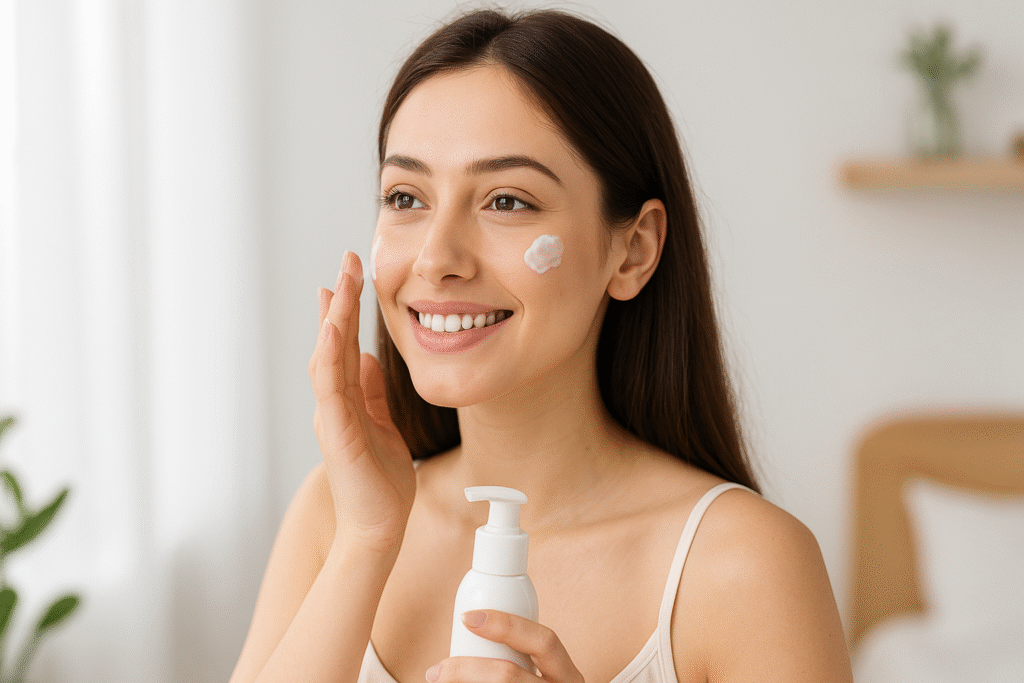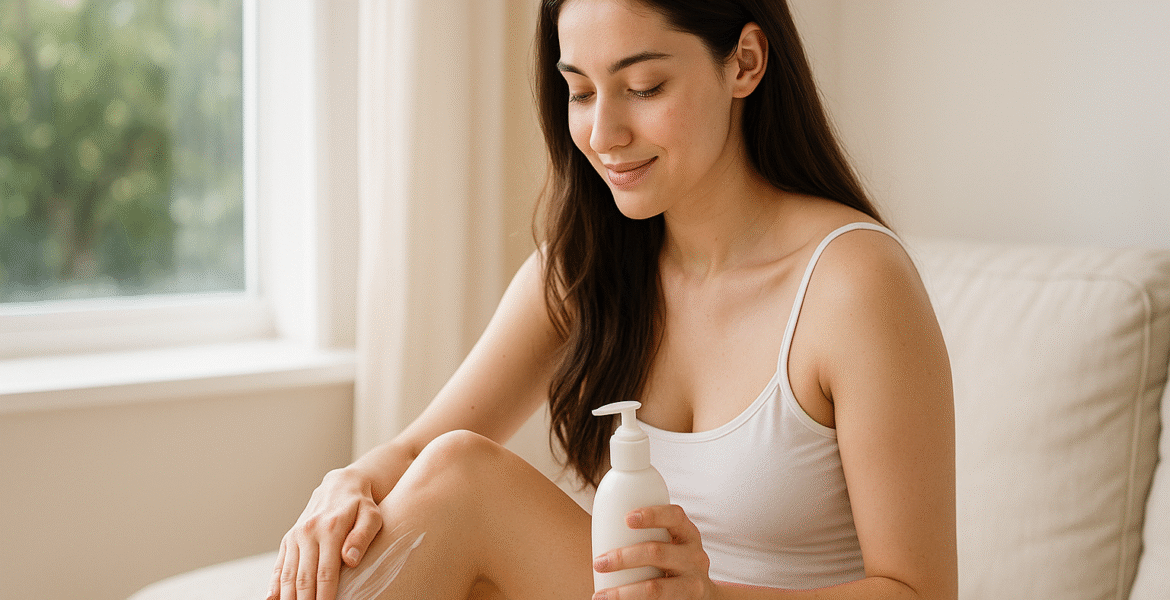Quick Definition: “Moisturizer” is the umbrella term for any product that stops water from escaping your skin. Lotions, creams, gels, and butters are simply different textures within that larger family—distinguished mainly by how much water versus oil they contain.
Why the Distinction Matters
Picking the correct texture pays you back in four ways:
- Longer hydration. The right formula keeps skin comfortable for eight to twelve hours, whereas the wrong one can leave you flaky or shiny by lunchtime.
- Barrier repair. A balanced humectant-plus-occlusive blend can cut transepidermal water loss (TEWL) by more than half, reducing redness and sensitivity.
- Make-up longevity. Foundations glide on smoothly over a well-matched base and pill over a mismatched one.
- Wallet health. When each product has a clear purpose you finish bottles instead of hoarding half-used jars.
Meet the Moisturizer Family

Think of moisturizers as a lineage:
- Gels are at one extreme—over 80 % water, almost zero heavy oils. They sink in fast and leave no residue.
- Lotions hover around a 70 : 30 water-to-oil ratio. They feel fluid and breathable—ideal for normal or combination skin.
- Creams land in the middle, roughly half water, half oils and butters. That balanced profile suits dry or winter-exposed skin.
- Body butters and ointments flip the script—less than 20 % water but lavish in solid lipids or petrolatum. They’re rescue balms for cracked heels, elbows, or eczema patches.
Ingredient Anatomy 101
Every hydrator contains three building blocks:
- Humectants (glycerin, hyaluronic acid, urea) pull water into the upper layers of skin.
- Emollients (squalane, triglycerides, plant oils) smooth rough edges between skin cells.
- Occlusives (petrolatum, shea butter, dimethicone) form a breathable seal that slows evaporation.
pH Corner. Your skin’s enzymes thrive at pH 4.5-5.5. Products far outside that window can sabotage barrier repair, so spot “pH-balanced” on the label or check brand lab data when possible.
Texture Showdown in Plain English
- Gel: cooling splash that vanishes in seconds—great for oily or humid climates.
- Lotion: feather-light milk that hydrates without film; a perfect everyday workhorse.
- Cream: silky cushion that leaves a whisper of richness; best friend of dry, flaky skin.
- Butter/Ointment: dense balm that melts with body heat, ideal for night-time or wind-burn.
Water-to-oil ratio steps down as you travel from gel to butter, so pick what feels good and what your environment demands.
Skin-Type Playbook
Oily / Acne-Prone
Use oil-free gels or lotions labelled non-comedogenic. Niacinamide and green-tea extract help temper shine.
On isotretinoin? Jump to the Accutane sidebar for special instructions.
Dry / Dehydrated
Layer a humectant-rich lotion first, then a ceramide-heavy cream. Ingredients like urea 10 % and squalane rebuild softness fast.
Combination
“Multi-moisturise”: swipe lotion down your T-zone and dab cream on cheeks. Rotate lighter textures in summer, richer ones in winter.
Sensitive or Eczema-Prone
Fragrance-free, pH-balanced creams reign supreme. Dodge alcohol-laden lotions and citrus essential oils that can sting.
Aging Skin—40s, 50s, 60 +
- 40s: Peptide lotion by day, ceramide cream by night.
- 50s: Same, but introduce an occlusive balm during cold months.
- 60 +: Add cholesterol-rich creams and antioxidant gels to fight dullness.
Climate Guide
In humid tropics like Miami or Chennai you’ll thrive on gel-lotions in the morning and perhaps a thin cream under nightly AC.
Hot, arid zones such as Phoenix or Rajasthan need an aloe-based gel for daytime comfort but a mid-weight cream after sunset to defeat desert dryness.
Temperate cities—think Berlin or Bengaluru— let you keep a single reliable lotion year-round, swapping to cream only in a cold snap.
Sub-arctic climes like Oslo or Shimla in winter demand a cream with shea butter by day and a bona-fide body butter before bed to block frigid winds.
Medication & pH Sidebars
Accutane Alert. Oral isotretinoin shrinks oil glands dramatically, so water escapes faster. Bump up to thick ceramide creams and top with a fingertip of petrolatum on flaky spots until treatment ends.
pH Reality Check. If your cleanser or exfoliant is already acidic, balance it with a neutral pH lotion rather than compounding acids that could irritate.
Natural vs Synthetic Occlusives
Natural occlusives like shea butter, cocoa butter and beeswax bring antioxidants and a pleasant “melt”, but can feel heavy or trigger scent sensitivities. Synthetic options—petrolatum, dimethicone, and polyisobutene—tend to be lighter, hypoallergenic, and formally non-comedogenic. Choose the one whose texture you’ll actually use enough to do the job.
Layering Flow
- Cleanse with a gentle, low-pH wash.
- While skin is still slightly damp, spread a lotion or gel—this is your water magnet.
- After 30 seconds, press on a cream to lock that hydration inside.
- In the morning, finish with broad-spectrum SPF 30 +; at night, seal with a touch of petrolatum if air is especially dry.
Three Persistent Myths—Busted
- “Lotions are useless in humid weather.” – False; indoor air-conditioning mimics desert conditions.
- “Thick creams always clog pores.” – Petrolatum has a comedogenic rating of 0, so technique matters more than thickness.
- “Body butter doubles as sunscreen.” – No occlusive blocks UV; you still need SPF.
Dermatologist Check-List
Call a professional if:
- An itchy rash lasts beyond two weeks even after switching to fragrance-free cream.
- You see oozing, crusty patches right after introducing a new lotion (possible allergic contact dermatitis).
- Cystic acne persists despite using oil-free moisturizers—oral therapy might be needed.
Best-in-Class Products and Why They Won
- Neutrogena Hydro Boost Water Gel —chosen for its high-molecular-weight hyaluronic acid, fragrance-free formula, and reasonable price per millilitre.
- CeraVe Moisturizing Cream —beats similar options by packing three essential ceramides plus niacinamide for barrier repair.
- Re’equil Ultra-Matte SPF 50 Lotion —offers mineral zinc oxide with a dry-touch finish, perfect under Indian summer humidity.
- The Body Shop Shea Body Butter —contains unrefined, fair-trade shea and a thicker consistency than most supermarket butters, ideal for elbows and heels.
(We skipped other popular picks where fragrance levels or import mark-ups didn’t justify the extra cost.)
Seasonal Transition Mini-Guide
- Monsoon to Winter: Replace your lightweight lotion with a balanced cream and dab a petrolatum balm on flaky zones at night.
- Summer to Humid: Switch back to gel formulas, but keep blotting papers handy and re-apply lotion after mid-day face washes.
- Heading for a Ski Trip: Even if you live in the tropics, take a small jar of body butter and apply after each run—high-altitude air is bone-dry.
Key Takeaways
- Moisturizer refers to all hydrating products; lotions, creams, gels, and butters are simply textures.
- Match texture to your skin type and climate for all-day comfort.
- Ideal pH is 4.5–5.5; anything far outside slows repair.
- Petrolatum can block up to 99 % water loss in a lab but more realistically 30-60 % at home—still a big win.
- Re-visit your routine during medication, season changes, or travel.

